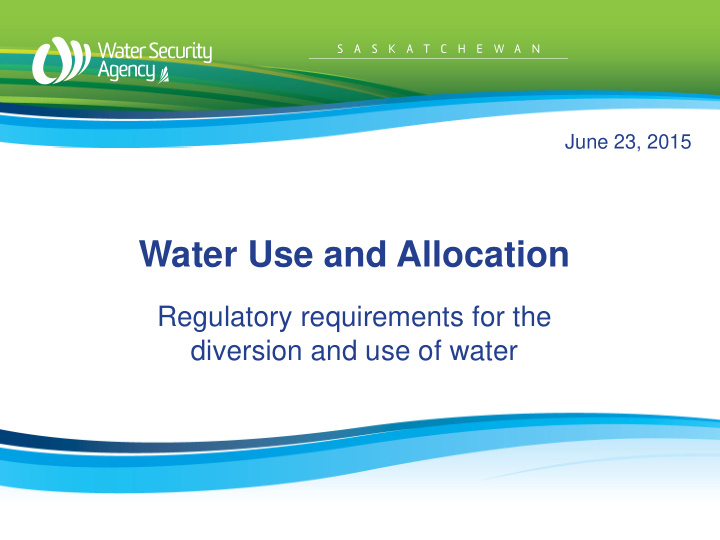



June 23, 2015 Water Use and Allocation Regulatory requirements for the diversion and use of water
The Water Security Agency was created in October of 2012 to support the Saskatchewan Plan for Growth and to deliver the 25 Year Saskatchewan Water Security Plan. By bringing together governments expertise and responsibilities for water, the WSA will ensure a comprehensive and integrated approach to water management.
The WSA is responsible for: • Operation, management and safety of provincial dams and water conveyance works; • Protection of drinking water and the regulation of municipal water and waste water treatment facilities; • Protection of source water quality and aquatic habitat; • Flow, lake level, and flood forecasting; and, • Water supply planning, allocation of surface and ground water, and water conservation.
“Whiskey if for drinking; water is for fighting over.” (Mark Twain?)
Overview • History of water rights in Saskatchewan • What water rights are • What they are not • Regulatory process for surface water • Regulatory process for ground water • Temporary water rights • Industrial Water Use Charges • Water Rights Assurance
Water rights and approvals • Pre 1894 British Common Law, riparian rights, rule of absolute capture. • 1894 The North West Irrigation Act, water vested in Federal Crown. • 1931 The Water Rights Act, water vested in Provincial Crown. • 1959 The Ground Water Conservation Act, regulates the development and use of wells. • 1984 The Water Corporation Act (SaskWater) • 2002 and 2005 The Watershed Authority Act (SWA) • 2013/14 The Water Security Agency Act
Any use or diversion of water requires approval (almost) Section 57(1) Subject to subsection (2), unless authorized to do so by the corporation, no person shall: (a) divert or use any surface water; or (b) construct or cause to be constructed any works for the purpose of diverting or using surface water. (2) Nothing in this Act or the regulations restricts the right of a person owning or occupying land that adjoins a body of surface water to use any quantity of that water that the person may require for domestic purposes on the land, but the person is not entitled to divert or use surface water by any works unless: (a) the authority to do so has been obtained pursuant to this Act: or (b) the person is exempt from the requirement of obtain the corporation’s approval pursuant to subsection 59(2). Subsections (3) and (4) are similar but deal with ground water.
Water Rights Licence and Approval of Works While Sections 57(1) and (3) both speak to the use of water as well as the works required to divert water, the approval for each is distinct. The right to use water is granted in the form of a water rights licence issued pursuant to Section 50(1) Approvals to construct and/or operate surface or ground water works (two separate approvals) are issued pursuant to Section 62(1) This allows for the separation of the approval to operate water distribution works from the right to use water, and precludes operators from making allocation decisions.
Water Rights Are Not Transferable: Water rights cannot be traded, bought or sold. The right to use water can only be established pursuant to the Act. Appurtenant to the land: Approvals of works are issued “for the works” and are registered on title and made appurtenant to the land, and as such carry forward following sale. Water Rights are issued “to the person” and expire automatically on the transfer of land. First in time, first in right: Unlike other jurisdictions (e.g., Alberta) water rights do not carry a priority of use based on the date of application/issuance. In the event of shortage WSA may restrict the right to use water provided under any licence issued. A guarantee of availability: The WSA retains the right to restrict water use at all times. A water right does not guarantee that water will be available.
Surface Water Approvals Process • Application for Water Rights Licence and Approval to Construct and Operate Works. • Supported by suitable plans and fees • Adequate land control • WSA determines sustainability of proposed water source. • Approval to construct / term water rights licence issued • Following confirmation that works are as proposed, an approval to operate and water rights licence with defined term, and conditions is issued. https://www.wsask.ca/Permits-and-Approvals/Regulatory-Info/Surface-Water-Approval- Process/
Groundwater Approvals Process • Permit to Conduct Ground Water Investigation per. The Ground Water Regulations requires the submission of engineering approvals, well logs and pump test results . • Application for Water Rights Licence and Approval to Construct and Operate Works. • Supported by suitable plans and fees • Adequate land control • Approval to construct and term water rights licence (if appropriate) • Approval to operate and water rights licence with defined term, and conditions. https://www.wsask.ca/Permits-and-Approvals/Regulatory-Info/Surface-Water-Approval- Process/
Temporary Industrial Water Use https://products.wsask.ca/
The use of water for industrial purposes is subject to payment of Industrial Water Use Charges as prescribed in the Saskatchewan Watershed Authority Regulations.
Water Rights Assurance • There is currently sufficient un-allocated excess capacity in Lake Diefenbaker and the Qu’Appelle River System to meet the needs of multiple industrial projects.
Water Rights Assurance To meet the needs of development the WSA established a process for the issuance of a Water Rights Assurance in 2012. In March of 2015 the Government of Saskatchewan announced the implementation of a Water Rights Assurance Fee.
Licensing and Water Use 111 Fairford Street E. Moose Jaw, SK S6H 7X9 F 306-694-3944 Jeff Hovdebo , Manager & Acting Director P 306-694-8915 Andrew Thornton , Supervisor, Licensing and Water Use Data P 306-694-3746 Brian Hauck , Senior Technician, Water Rights & Approvals P 306-6943103 Dave Messner , Senior Technologist, Water Rights & Approvals P 306-694-3029 Jayson Ford , Senior Technician, Water Rights & Approvals P 306-694-3433
Recommend
More recommend